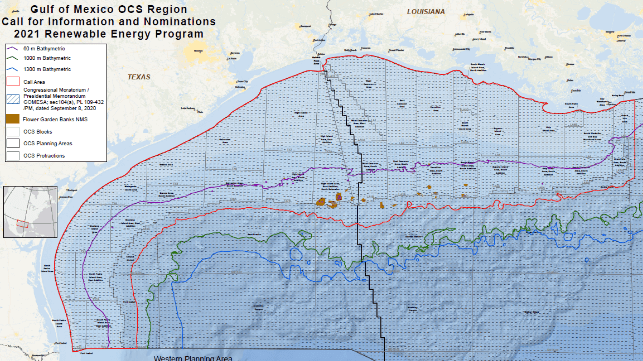BOEM Begins Environmental Review for U.S. GoM Wind Lease Areas

The U.S. Bureau of Ocean Energy Management announced Tuesday that it is opening the environmental-assessment phase for planned offshore wind lease sales in the U.S. Gulf of Mexico. The call area covers a vast swath of the Western GoM, including virtually all federal waters between the maritime boundary with Mexico and the Mississippi Delta, out to a depth contour of about 800-1000 meters.
“The Gulf of Mexico is well-positioned to support a transition to a renewable energy future, as much of the infrastructure already exists to support offshore wind development in the region,” said BOEM Director Amanda Lefton. “BOEM’s Environmental Assessment is an important step to ensure that any development in the region is done responsibly and in a way that avoids, reduces, or mitigates potential impacts to the ocean and to ocean users."
BOEM first announced its plan to solicit input for potential wind farm development in this area in November. It will narrow the area covered based on stakeholder input, resulting in designated "wind energy areas" - locations that appear most suitable for wind energy development.
In the environmental assessment, BOEM will look at the possible environmental consequences of bottom surveys (geophysical, biological, etc.) and site assessment activities (like the installation of met buoys) associated with the wind lease sale process. The more detailed environmental impact statement (EIS) process comes after each lease sale, when the developer submits a construction and operations plan.
A public consultation period is under way to solicit input on the impact of offshore wind development in the region. Fishing interests are often more affected by offshore wind development than others, and BOEM has scheduled a series of consultations for commercial and recreational fishermen from January 19-20.
The U.S. Gulf of Mexico has relatively low average wind speeds and an unfortunately high risk of hurricanes, but it makes up for these disadvantages with its extensive industrial base for building, deploying and servicing offshore structures. Many of the foundation jackets and service vessels for U.S. East Coast offshore wind farms will be built on the Gulf Coast, leveraging the Gulf offshore oil industry's experienced labor pool; for developments in the Gulf of Mexico, that capability is right next door.
